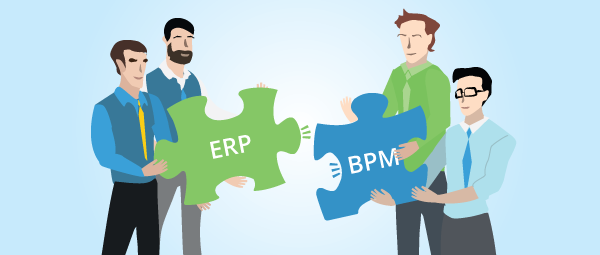BPM and ERP in a Single Company: Myth or Reality?
Blog: BPM Leader
What’s the use of BPM for a company that has already implemented ERP? Is a BPM system really needed in this case?
It is difficult to imagine a company operating without an ERP support. However most companies that have implemented ERP soon face the problem of adjusting their hard-coded processes to the changing customer demands and market conditions. It is well known that any upgrade of a large ERP system is quite risky for the business and requires significant investments. By the time new functionality is added, the upgrades may become irrelevant and deliver little or no return on investment.
To make your IT infrastructure more flexible and adaptable to the changing business environment, it may be a good idea to complement ERP with a BPM system.
Four possible coexistence scenarios for BPM and ERP

From our experience, we have learned that BPM and ERP can coexist most successfully. There are four possible scenarios:
BPM adds to the ERP functionality
Since automation of processes in ERP is long and expensive, companies often choose to automate only their core processes or the most critical process areas. What is a core process? It is the main activity of the company, which aims to make a profit. Take for example a furniture factory, its core process looks as follows: first, they procure materials and produce furniture, then they deliver the furniture to the client, assemble and provide warranty services.
Often core processes are automated only partly. In the furniture factory, the procurement and production can be handled by an ERP system, while the delivery, assembly and warranty services still remain manual operations.
A BPM system can be used to cover non-automated process areas, in order to reduce risk, improve flexibility and sustainability of the core process.
ERP takes care of core processes while BPM automates supporting processes
Supporting processes are designed to provide support for the core processes; unlike the core processes, they do not generate profit and often cause a drop in productivity. Let us come back to our example of the furniture factory. If a grinding machine breaks down, the core process will be suspended until the repair work is complete. The repair work is nothing else but a supporting process. If it is well organized, the equipment will be mended without delay, the downtime will be reduced and the productivity losses will be minimal.
Another example is the dismissal of an employee who works with the machine. To find and hire a new employee is another supporting process. In large companies such processes may amount to the hundreds and they all affect the core process more or less.
If a core process can be successfully automated by means of an ERP system, for the supporting processes, nothing is better than a BPMS.
BPM integrates with ERP
It is not a secret that some ERP vendors provide their best practices for the core process automation. As a result, companies that lack resources for customization, have to reorganize their work in order to comply with the best practices for the industry, which an ERP vendor provides. In some cases, the reorganization does not require big investment, but more often than not, well-established business processes simply cannot be adapted in this way.
In this regard, a BPM system is used to automate processes with complex logic. At the same time, integration with ERP provides all necessary data and assures sustainable functioning.
ERP for automation, BPM for control
Many large companies that have invested in automating their processes with ERP are unhappy with the lack of process monitoring tools. Companies need a system that enables them to track and measure process performance and KPIs in real time.
Consider a loan origination process, which is typical for any bank. This process is automated with the bank’s IT systems. However, it is quite difficult to track the number of running process instances, check the current process stage, and find out how long it takes to complete an operation. Decision-makers are frustrated by lack of easy access to the information they need about the business. The main monitoring tools of a transactional system (ERP, core banking, etc.) are reports. It takes long to generate a report, yet frequently it is critical to solve issues in real-time mode, quickly find and eliminate bottlenecks in business processes.
In this case, a BPM system can be integrated with the company’s IT systems to track changes in processes in real time. Many BPM systems allow configuring process KPIs and offer dashboards for the real time monitoring. Working as an add-on to the company’s IT systems, they provide transparency and facilitate timely decision making.
Conclusion
Although both technologies can exist independently, we have shown that they can be effectively combined in one company. While ERP is the heart of the company, BPM supports the company’s vital processes providing flexibility and real-time monitoring much needed in the environment of change.
The post BPM and ERP in a Single Company: Myth or Reality? appeared first on BPM Leader.
Leave a Comment
You must be logged in to post a comment.







